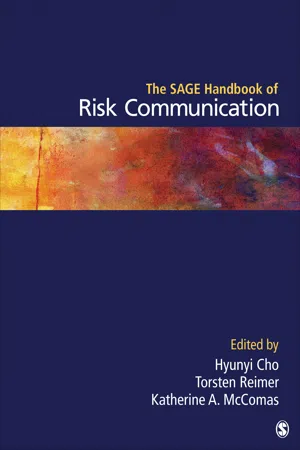
- 376 pages
- English
- ePUB (mobile friendly)
- Available on iOS & Android
The SAGE Handbook of Risk Communication
About This Book
In this comprehensive, state-of-the-art overview of risk communication, the field's leading experts summarize theory, current research, and practice in a range of disciplines and describe effective communication approaches for risk situations in diverse contexts, such as health, environment, science, technology, and crisis. Offering practical insights, the contributors consider risk communication in all contexts and applications—interpersonal, organizational, and societal—offering a wider view of risk communication than other volumes. Importantly, the handbook emphasizes the communication side of risk communication, providing integrative knowledge about the models, audiences, messages, and the media and channels necessary for effective risk communication that enables informed judgments and actions regarding risk. Editors Hyunyi Cho, Torsten Reimer, and Katherine McComas have significantly contributed to the field of risk communication with this important reference work—a must-have for students, scholars, and risk and crisis communication professionals.
Frequently asked questions
Information
Part I Foundations of Risk Communication
Section 1 Risk Perceptions of Individuals
Chapter 1 Risk Perception
Introduction
Defining Risk and Risk Perception
Social and Cultural Components of Risk Perception
Table of contents
- Cover
- Half Title
- Publisher Note
- Title Page
- Copyright Page
- Contents
- Acknowledgments
- Introduction: Explicating Communication in Risk Communication
- Part I Foundations of Risk Communication
- Section 1 Risk Perceptions of Individuals
- Chapter 1 Risk Perception
- Chapter 2 The Challenge of the Description–Experience Gap to the Communication of Risks
- Chapter 3 The Feeling of Risk: Implications for Risk Perception and Communication
- Section 2 Risk as Social Construction
- Chapter 4 Social Construction of Risk
- Chapter 5 The Role of News Media in the Social Amplification of Risk
- Chapter 6 Rhetoric of Risk
- Part II Components of Risk Communication
- Section 3 Models of Risk Communication
- Chapter 7 Risk Information Seeking and Processing Model
- Chapter 8 The Societal Risk Reduction Motivation Model
- Section 4 Audiences of Risk Communication
- Chapter 9 The Role of Numeracy in Risk Communication
- Chapter 10 Edgework and Risk Communication
- Section 5 Risk Communication Messages
- Chapter 11 Numeric Communication of Risk
- Chapter 12 Narrative Communication of Risk: Toward Balancing Accuracy and Acceptance
- Chapter 13 Visual Messaging and Risk Communication
- Section 6 Risk Communication and the Media
- Chapter 14 Media Portrayal of Risk: The Social Production of News
- Chapter 15 Framing, the Media, and Risk Communication in Policy Debates
- Chapter 16 Social Media and Risk Communication
- Part III Contexts of Risk Communication
- Section 7 Interpersonal Contexts of Risk Communication
- Chapter 17 Risk Communication in Provider–Patient Interactions
- Chapter 18 Informed Consent
- Section 8 Organizational Contexts of Risk Communication
- Chapter 19 Risk Communication in Groups
- Chapter 20 Crisis Communication
- Section 9 Risk Communication in the Public Sphere
- Chapter 21 Social Movements and Risk Communication
- Chapter 22 Public Engagement in Risk-Related Decision Making
- Glossary
- Author Index
- Index
- About the Editors
- About the Contributors